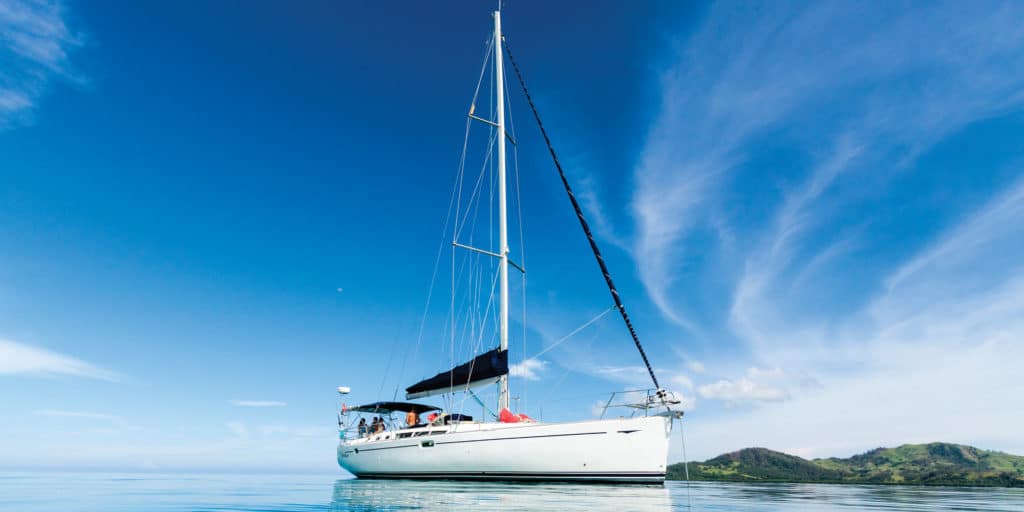
Once upon a time, in what now feels like a former life, I visited a small village on a remote bay in Fiji. Daku village, on Kadavu Island, used to be frequented by a steady stream of cruising sailors in search of a deep connection to the local culture, though today, it seems to have dropped off of most Pacific cruisers’ radars. Just an overnight sail away from the bustle of Fiji’s main island of Viti Levu, Daku was full of happy memories for me of a time spent anchored off the village decades ago while I was cruising on Mahina Tiare, a 31-foot Hallberg-Rassy sloop. For years, I’d dreamed of returning, but time passed and life got in the way. Then a happy coincidence appeared in the form of an email from a friend who had recently visited Daku. She photographed my entry on the first page of the Daku yacht log. The entry was like a message in a bottle from my former self, reminding me that I’d written in the logbook that I would return one day. My former cruising partner and I had started the log for our Daku friends, Epi and Kata Ravono, 25 years ago.
With just this email, the plan for going back to Fiji was set in motion. But this time, since I no longer have a cruising boat, it would be on a charter boat — my maiden charter experience as a passenger rather than crew or boat owner.
We chose a crewed charter aboard Stellar, a 49-foot Jeanneau Sun Odyssey, which we found online. More than a simple vacation, I wanted to use this trip as a chance to introduce my partner, Bill; my sister, Pam; and my brother-in-law, Jim, to traditional Fijian culture and my long-ago Fijian friends. Stellar was the magic carpet to transport us.
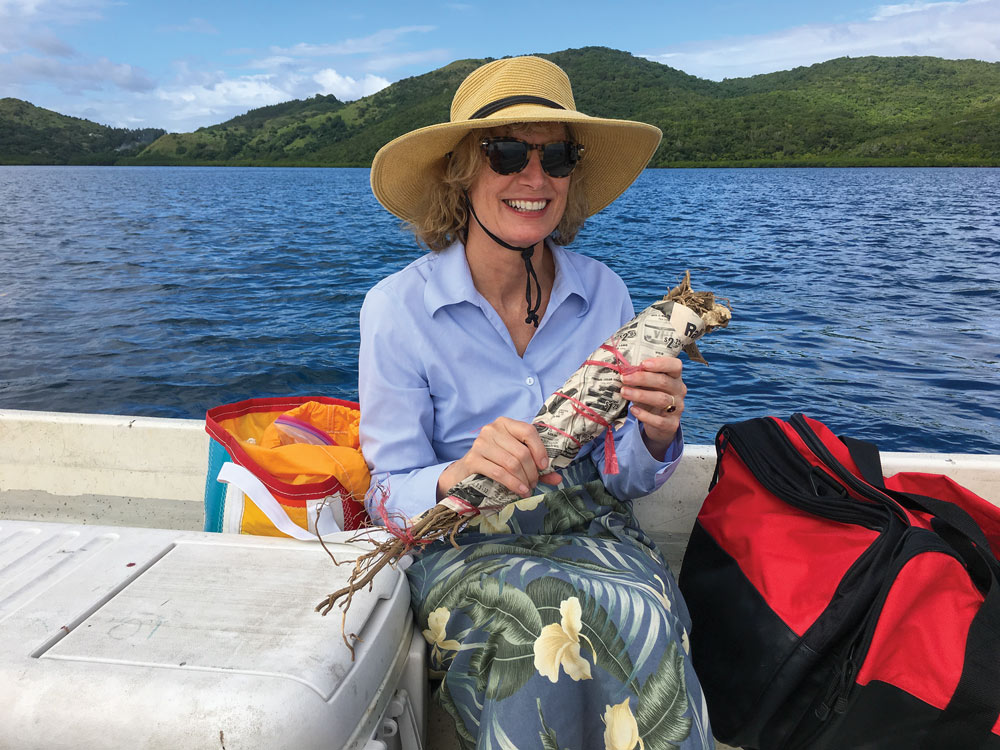
Shortly after stepping aboard, we left Port Denarau, on the island of Viti Levu’s west shore, and were comfortably motoring toward Tavarua Pass, destination: Daku village. Our Fijian crew — Julian May, the skipper; Eroni, our talented cook; and George, the friendly first mate — added immensely to our Fijian immersion over the ensuing week. And we, by sailing to a traditional village, were about to add to theirs.
Steele Jones, Stellar‘s Kiwi owner, recommended Julian to captain our charter because of his familiarity with Kadavu Island. Still, up until we stepped aboard, Steele tried to change our course. Thinking our proposed passage into trade winds would be too uncomfortable, he asked, “Are you sure you wouldn’t rather go to the nearby Mamanucas or Yasawas?”
Forget discomfort! I thought.
While napping on our long flight to Fiji, I’d dreamed we were sailing to Kadavu and remarked to myself while asleep, “Oh, it’s so calm.” My dream turned out to be prophetic. The typical 12- to 16-knot east-southeast trades were not blowing that morning, so Julian suggested we make a beeline for Kadavu. We found Daku Bay on his chart plotter, and he entered the coordinates to the anchorage.
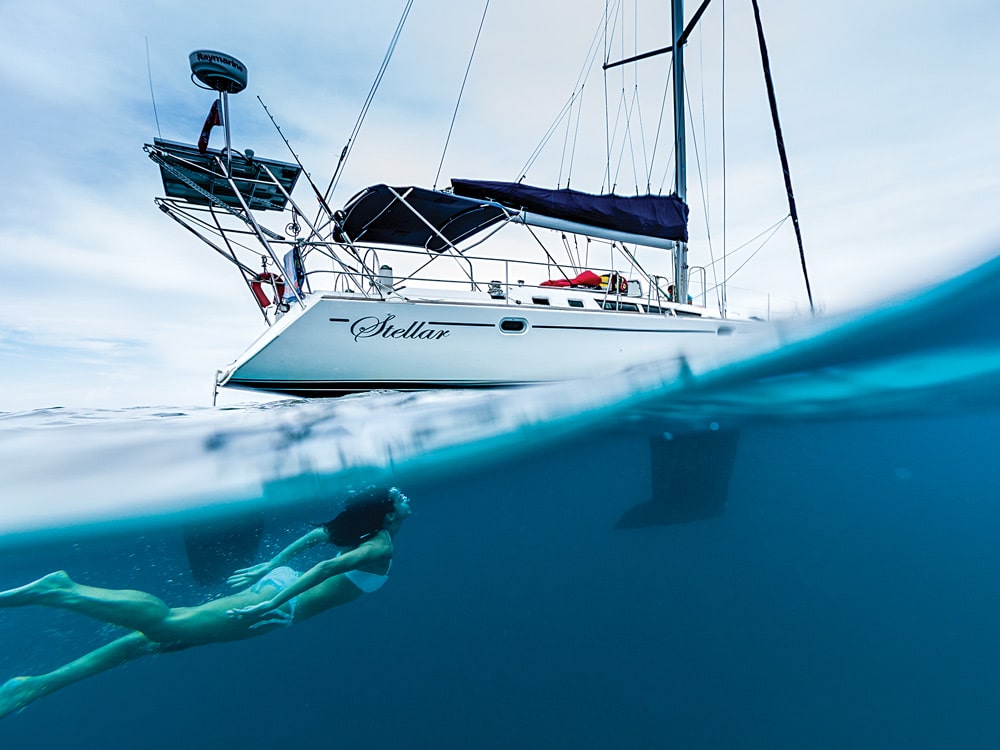
The worldly Julian told us, “I grew up speaking English. I tried to learn Fijian in school but instead spent too much time mucking about in boats.” His passion for boats had taken him all over the world. Moreover, when The Moorings had a base in Fiji, Julian led the bareboat flotillas, including one with Cruising World editors.
“I would be leading four or five boats, with a chase boat behind us,” Julian said. “I’d tell them, ‘Follow me. I know where the unmarked reefs are.’ Once in a while, someone would wander off and end up on a reef. They’d say, ‘That reef isn’t on the chart,’ after they’d hit it!”
This is the main reason that bareboat chartering in Fiji ended back in the mid-1990s. Since then, chart plotters, updated charts and excellent cruising guides have fortunately made it easier for cruising yachts to visit, and there are several options for crewed charters.
As we passed the world-renowned surfing spot Cloudbreak on our port side, it appeared as a translucent aqua band topped by thin, white spume, with surfers dotting its moving face. Behind, the dry, golden California-like hills of Fiji’s Coral Coast on Viti Levu provided a backdrop contrast. It was the last we saw of any other pleasure boats or tourists for almost a week.
Just after we transited Tavarua Pass outside the reef, a fat blue-green yellowfin tuna hit one of our fishing lines and was quickly reeled in by the crew. Then, the singing of three nylon lines unspooling at once was followed by pandemonium as George, Bill and Jim simultaneously reeled in three 20- to 25-pound skipjack tunas.
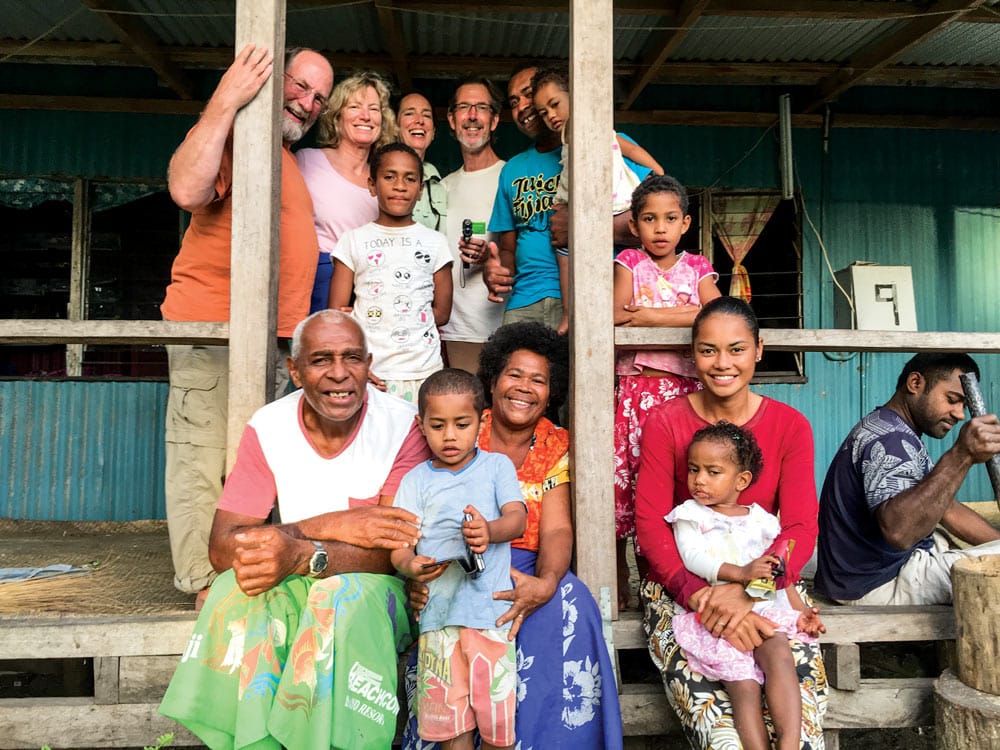
Zing! Another line spooled out as afternoon tea was served. Wahoo on the line! Jim fought to bring in the long-billed fish. We were motorsailing as a band of thick purplish clouds clustered low on the horizon to starboard. A squall hit suddenly with 20 knots of wind, and the rain felt like needles. As we flew along at 8 knots, another fish struck — this time a beautiful dorado.
“Six fish in four hours,” I said. “Maybe the villagers are praying for us.” In truth, Julian was somewhat of a fish whisperer. This wasn’t meant to be a fishing charter, but our Fijian crew loved to fish. The charter was becoming as much our crew’s trip as ours, which was as it should be.
Just after we transited Tavarua Pass outside the reef, a fat blue-green yellowfin tuna hit one of our fishing lines.
Early the next morning, the engine’s rpm changed and sails were furled. I automatically shot up on deck. It was strange for me to sleep through most of the night and not stand watch. Years of cruising on Mahina Tiare and teaching sail training on Alaska Eagle had ingrained in me the need to help on deck when something changed. I put on shoes, grabbed a flashlight and made my way forward to help Eroni as he lowered the anchor chain. I was incredulous that we passed through the unmarked reef in inky darkness!
Morning revealed our anchorage was actually outside the reef. Smart move, I thought. Julian admitted that he’d never been into Daku Bay before and, wisely, he had entered the coordinates for the bay outside the complicated reef system.
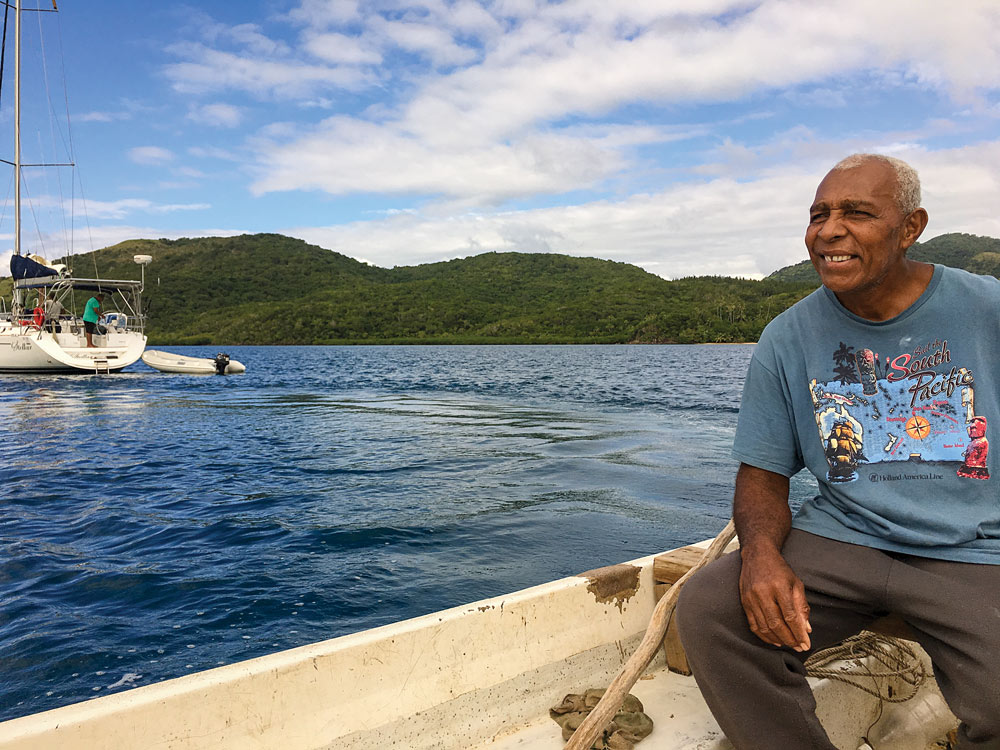
Looking around in daylight, I felt like a cat, homing in on a familiar place after being lost for a long time. Slowly the shape and tropical texture of Kadavu’s landscape stimulated long-ago memories.
Julian delivered fish to the village, and my old friend Epi arrived by motorized skiff to guide Stellar to the anchorage and take my family into the village. Since it was low tide, it was best to rely on local knowledge to thread our way from the anchorage through the coral outside the village to land.
Epi’s hair was now white, his demeanor a bit more serious, but his hillside gardens have kept him fit, and his mind was as curious as ever.
As we padded barefoot into the village, the bright-green ground cover was deliciously cool, spongy and soft. The village seemed charmed. The dozen or so houses were shaded by lush mango and big-leafed breadfruit trees. Chickens and roosters ran freely alongside a sow and her nine frisky piglets.
While many small Fijian villages are now deserted, Epi and Kata’s family and the whole village of Daku are thriving. Out of a population of 74, Daku has 30 children. The family had grown from five to 10 living in their home, which had doubled in size. They now offer the occasional rustic home stay to tourists, many of whom wish to experience traditional village life while staying at the nearby Papageno Resort. They are also visited once a year by the South Pacific Study Program for village stays; Epi was hired to give lectures on ecotourism to the group.
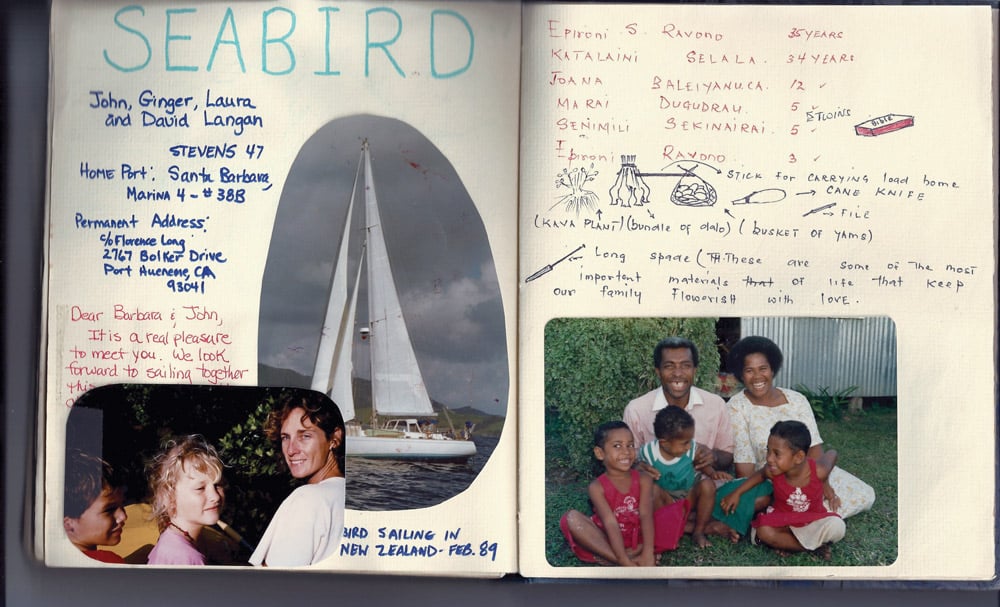
Epi loaned Jim and Bill sulus (Fiji’s version of a sarong) to participate in sevusevu in the chief’s house. Sevusevu, a formal welcome and permission to visit the village, was also a blessing for our village stay. Any visit to a traditional Fijian village, to be proper, should include sevusevu, which involves gifting the chief a half-kilo bundle of kava.
Sevusevu completed, Epi’s wife, Kata, was as welcoming and busy as I recall. Her rustic kitchen now had running water part of the day and a propane stove, but she still preferred cooking over a wood fire. They also now had a generator, electric lights and a DVD player, but overall, the peaceful village vibe hadn’t changed.
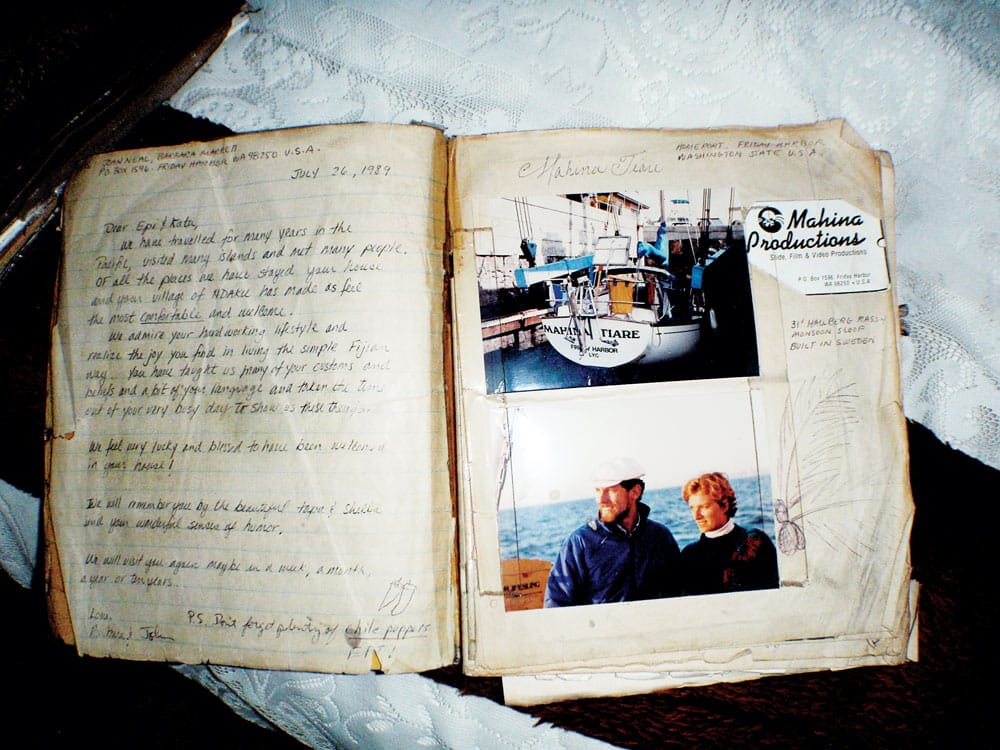
Dinner ashore was a treat, although sitting on the cool woven pandanus mats on Epi and Kata’s floor was easier in my 30s. Everything, from the coconut milk to the kumquat jelly and juice, was made from scratch. The fish in ginger-and- soy gravy was caught by hand, and the vegetables and limes were grown in Epi’s garden.
When the tea made from lemon leaf was poured, I exclaimed, “Drau-ni-moli tea!” Everyone was surprised I remembered the name. I’d shared many meals with Epi and Kata when we were young and their children were small. Now Epi Jr. is married, and he and his wife, Wati, live in the house, along with his sister, Maraia, and her three daughters.
Epi invited Stellar‘s crew to drink kava that evening and warned them to “come prepared.” The men spent hours drinking and laughing as the coconut cup was passed around the ancient wooden kava bowl.
Kadavu is famous for growing Fiji’s best kava. It’s prepared the traditional way, using long strands of shredded bark, instead of cloth, to strain the root bits out of the mud-colored, medicinal-tasting liquid. Our crew, Eroni and George, savored its strength. Jim and Bill not so much! Julian remained on board to catch more fish.
Kata’s rustic kitchen now had running water part of the day and a propane stove, but she still preferred cooking over a wood fire.
While the men drank on the veranda, darkness settled in. Inside, a bag of bootleg DVDs emerged and 21 children silently filed in to watch. Pam and I were on the floor among a sea of nut-brown faces, watching the movie Pitch Perfect. It seems projectile vomiting is funny in any culture! At 8 p.m., all the children silently filed out — Epi’s rule on school nights.
Bill and I slept ashore in the guest room on a comfortable mattress, while the family slept in separate rooms on pandanus mats. We quietly tiptoed out at night. The stars were brilliant in the velvet bowl of the sky, and Kadavu parrots squawked from a towering 300-year-old banyan tree. I couldn’t help reflecting — the tree has stood sentinel as Daku’s fierce warrior culture was transformed into today’s peaceful, cellphone-carrying Christian village.
At 4 a.m., the village roosters started a fierce crowing competition by our window, and two hours later, the family joined together to pray outside our door.
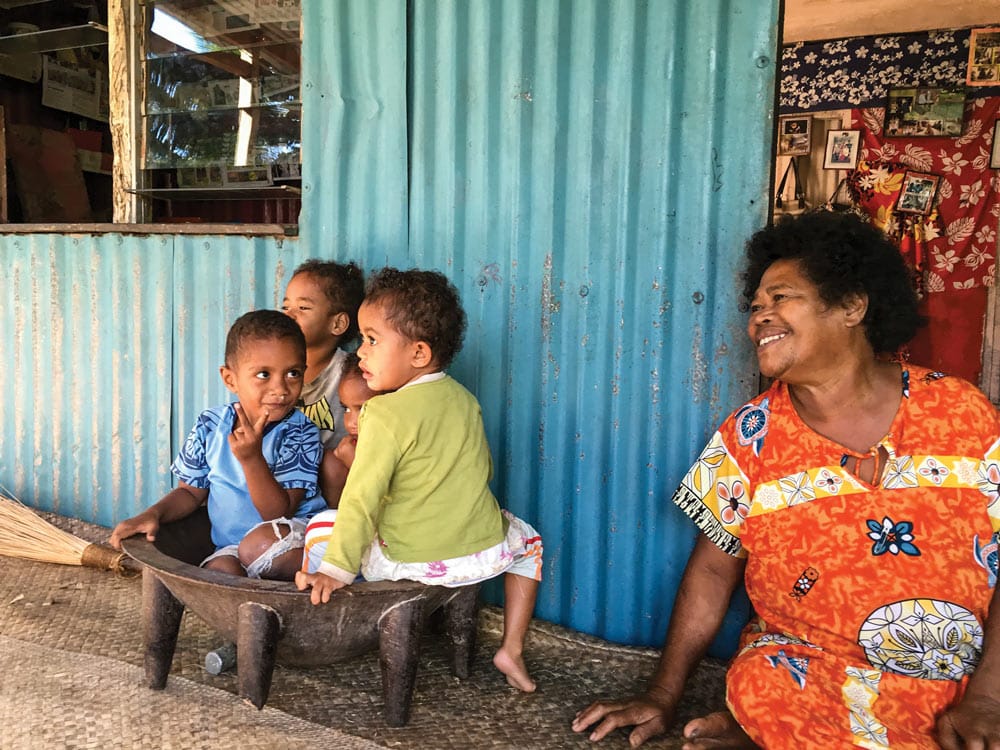
It was picnic day, so we all piled into Epi’s skiff. He sat on the bow, looking back, with his granddaughter, little Kata, in his lap — a big grin on his face as he surveyed his family and guests. We disembarked on the family’s deserted beach. As if by magic, Epi quickly built a fire to cook cassava root and then weaved a basket out of a green palm frond to transport coconuts.
While we snorkeled nearby, a colorful bolt of fabric was rolled out on the sand. Mahimahi, red snapper curry and tuna in gravy were laid out along with bele leaves (Fijian spinach). Stellar’s crew arrived with chicken curry and rice — thankfully, because everyone, including Epi’s family, seemed tired of eating fish. The village’s chicken and pork were reserved for special occasions, such as weddings and funerals.
We stayed an intense and memorable few days at Daku. They would have liked for us to stay longer to see dancing and to teach us tapa cloth making, but we felt the need to move on. Kata was suffering from a painful mouth infection while still managing a household of 10, without the benefit of even a clothes washer! As her guests, we were acutely aware that we were adding to her burden.
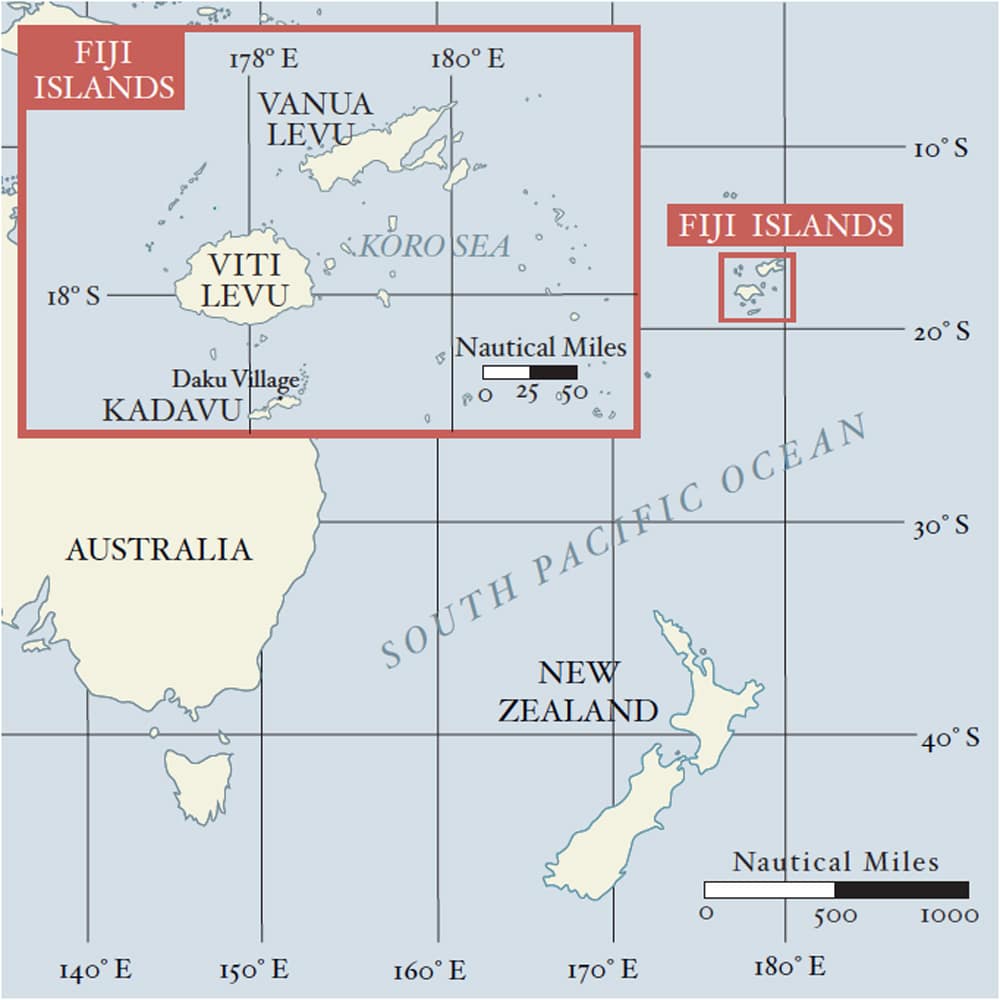
As we departed the beach, tears welled in my eyes and glistened in Epi’s and Kata’s too. Our respective islands are separated by 5,800 miles of ocean. I took solace in that perhaps the next generation of Marretts and Ravonos will meet and continue this story. I left Daku with the hope that cruisers will again experience the magic of this village, and add their names to the yacht log started years ago.
For the rest of our weeklong cruise, Julian slowly reintroduced us to civilization until our final night’s barbecue at Musket Cove, a busy cruisers hangout. Not only was Julian an excellent skipper, he was an astute judge of his clientele’s desires.
A charter was the perfect way to revisit Fiji during this season of my life and share a taste of the cruising life with my family. And, not being responsible for sailing, cooking or provisioning allowed me to fully relax and enjoy the adventure.
Barbara Marrett has been a contributing editor to Cruising World since 1993. Mahina Tiare, Pacific Passages, her and John Neal’s South Pacific adventure book, is now available as an e-book from amazon.com.
Why Charter in Fiji?
Taxis, crewed charters, provisions and fine-quality native carvings and crafts are more affordable in Fiji than in French Polynesia or the Caribbean. The reefs in general are in good shape, other than the recent isolated damage from 2016’s cyclone Winston, and provide world-renowned snorkeling and scuba diving just over the side of your boat. Fiji offers incredible variety — you’ll find lush mountains with rivers and waterfalls; deserted coral islands and semi-sophisticated towns; and good shopping, museums, a university, ornate Hindu temples and exotic East Indian restaurants. The culture is more intact than most tropical cruising areas, and it’s possible to see the traditional way of living among very friendly people.
Practicalities
The best time to visit Fiji is May to November, when the southeast trade winds blow, making it cooler and drier than the summer months and avoiding cyclone season. Pick up a free Mariners Guide to Fiji at any marina; it’s updated annually. Find it online at fijimarinas.com.
Resources
Safari Charters Fiji (Stellar): fijisafari.com
Fiji Weather: met.gov.fj
Practical information: noonsite.com/Countries/Fiji








